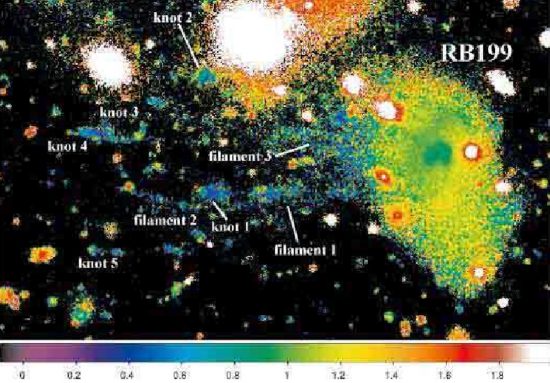
February 3, 2020
Gravity and other kinetic forces are inadequate when it comes to galactic formations.
The Coma Cluster of galaxies is a roughly spherical region about 3.5 million light years in diameter over 300 million light years from Earth. According to calculations, it is one of the most compact mass accumulations in the observable Universe, with more than 1000 galaxies inside a concentration of gas and dust over 100 million Kelvin. Intense X-rays blaze out from Coma’s central region. The explanation for that temperature eludes conventional explanation.
Astronomers studying data from the 8.2 meter Subaru Infrared Telescope at the summit of Mauna Kea in Hawaii discovered “threads” emerging from one of the large elliptical galaxies within the cluster, RB199. The filaments extend more than 260,000 light years from the galaxy, with groups of stars in close association enclosed by glowing, ionized shells. Astrophysicists refer to those knots as “fireballs”.
What caused the compact knots of stars to form? One idea is that gravitational “tidal forces” pulled out stars and gas as another galaxy passed close by. Another is based on movement toward the center of the Coma Cluster. As the galaxy accelerates into the central mass, “blow-back” force is thought to push the formations out and away. However, neither conjecture can explain the star-clumps and the knotted gas whose temperature exceeds tens of million Kelvin.
“Ram pressure” as the galaxy crashes into into the center of the Coma Cluster is supposed to create friction from the Cluster’s hot gases “scraping against each other”. That effect is said to strip material off RB199, creating the superheated stellar fireballs.
As written previously, wind socks, shock waves and collisions are often used to describe phenomena that create high-frequency electromagnetic radiation. Consensus astronomers rely on gravity and acceleration for the production of gamma rays, X-rays and extreme ultraviolet light in space. Hydrogen gas compression is supposed to create enough transfer of momentum that it reaches temperatures greater than the cores of some stars. In other words, it is the high temperature of the gas that makes it glow so brightly.
Previous Picture of the Day articles note that many structures in the Universe are active energy sources—some galaxies eject charged matter out from their poles, or leave long braided tails extending for thousands of light-years. Smaller formations (stars and planetary nebulae) have hourglass shapes composed of tightly bunched filaments. Such filamentary structures are known as Birkeland currents.
Plasma cosmologists know that filaments extending from active “radio” galaxies to the “radio lobes” far above their poles are the signature of Birkeland currents. Almost every body in the Universe displays some kind of filamentation. Venus, for example, has a tail composed of what NASA scientists call “stringy things.” Comet tails are composed of “stringy” ion tails. The glow from planetary nebulae resolve into intricate webs. The jets of Herbig-Haro stars and energetic galaxies are often resolved into braided filaments, and the spiral arms of some galaxies look “hairy” with threads of material extending from them.
All those filaments are Birkeland currents, but they only represent the visible portion of an entire circuit. The rest of the circuit may generate magnetic fields that can be mapped, so the map will indicate the extent of the circuit. Every element in a galactic circuit radiates energy, and it must be powered by its coupling with larger circuits. The extent of those larger circuits is indicated by the observation that galaxies occur in strings.
In an Electric Universe, the filamentary knots exploding outward from RB199 are an example of electricity in space.
Stephen Smith
The Thunderbolts Picture of the Day is generously supported by the Mainwaring Archive Foundation.












